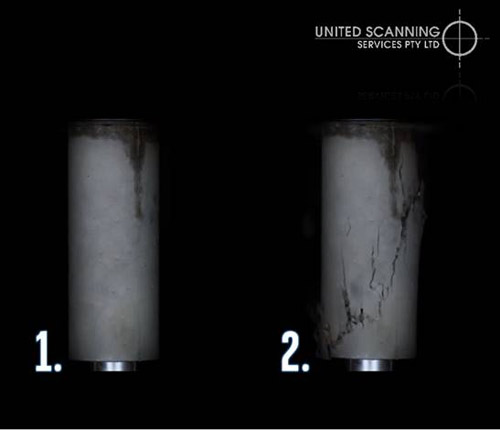Laboratory Materials Testing or What To Do When In Situ Testing is Not Enough
United Scanning are specialists in the application of Non-Destructive (NDT) in situ testing methods to the Construction industry and possess special expertise in the use of Ground Penetrating Radar for bridge and deck examination, pavement management, road and highway maintenance and for other large scale structures. However, there are times when the limitations of non-destructive testing are reached and insufficient information is available using the NDT toolset and methodologies and further information is required. To meet that need, United Scanning have partnered with a world leading laboratory accredited by the National Association of Testing Authorities, in order to be able to provide our clients with deeper analysis and truly independent 3rd party testing.
In order to be able to provide high quality and accurate information from the laboratory investigation, it is important that high quality samples are collected from the site. Given that the acquisition of sample material is inherently destructive, most clients require that the damage is minimised as much as possible. United Scanning’s expertise with Ground Penetrating Radar for concrete scanning means that they are able to select locations to acquire samples that optimise the balance between damage reduction and acquiring truly representative samples. More often than not, core samples provide the most reliable and useful sample type and United Scanning’s technicians are experienced at scanning sample locations to ensure reinforcement and other difficult to remediate features within the structure will not be effected by drilling for the core.
Working with our partner laboratory we can provide a range of materials testing including high definition petrographic examination, chemical analysis and physical materials testing. These will assist in answering important questions around durability, structural integrity, projected usage and maintenance planning.
High Definition Petrographic Examinations
High definition petrography is the optical examination of materials using tools to observe reflected and transmitted light. We use a variety of tools including the CSIRO developed QEMSCAN system (Quantitative Evaluation of Minerals by SCANning electron microscopy) and X-Ray diffraction. Using these extremely high end tools we are able to report on:
- Proportioning The exact proportions of different materials within the concrete like coarse aggregate, fine aggregate, natural sand, cement matrix, unreacted pulverised fuel ash, voids and water ratio

Figure 1: Concrete proportions
- Mixing and consolidation The presence of streaking, voiding, poorly bonded aggregate and other similar defects may indicate poorly mixed concrete. Large voids and honeycombing are usually indications poor consolidation. On the other hand, segregation and loss of air can mean the concrete was over-vibrated during the pour
- Causes of reduced durability Petrography will allow us to tell what the causes of concrete deterioration in the sample are. Chemical attack from acid, salt, alkali and sulphate, alkali-aggregate reactivity, abrasion, fire and heat, overload and impact are all causes of concrete deterioration in Western Australia. Petrography can provide indicators as to which of these factors is most significant in the sample
- Identify causes of low strength Low strength can be caused by problems with particular concrete batches, delays in pouring, proportioning (e.g. excessive air or pulverised fuel/fly ash) or the excessive addition of water to name just a few. Many of these causes can be identified and reported on via a petrography investigation
Identifying these factors can be essential to understanding deterioration in a structure like a bridge and possessing the knowledge of why cracking, delamination or blistering is occurring and at what age can allow for better selection of remediation strategies and implementation of ongoing
Chemical Analysis
Another area of testing that provides important insights is chemical analysis. This usually involves the addition of testing reagents with powder from the sample sites in order to identify key chemical characteristics. Some common tests performed on concrete include:
- Carbonation testing Carbonation occurs when carbon dioxide from the atmosphere penetrates the concrete and reacts with hydroxides within the concrete matrix. The result of this reaction is a hydroxide and the presence of the hydroxide within the concrete reduces the pH of the concrete. Concrete naturally protects the reinforcement within it from corrosion but as the carbonation occurs, the pH of the concrete falls until those protective properties no longer existing and corrosion commences (Cement.org, n.d.). Testing for carbonation is a way to understand the likely level of corrosion of the reinforcement and the potential life of structure
- Chloride content Chloride ions within concrete are the primary cause of early corrosion of reinforcement in concrete. US Federal Highway Administration (FHWA) studies reported (Clear, K.C. 1976) that that at a threshold limit of 0.20% total chloride by weight of cement, corrosion would be induced. Reinforcement in concrete that is exposed to salt, particularly if near salt water is particularly threatened and understanding chloride levels will contribute to an understanding of what factors will affect the life of the structure
- Cement content The cement content is an important factor in the durability of a structure. Too little cement may have resulted in weaker concrete than is needed. In addition, such concrete may provide inadequate protection for the reinforcement leading to premature corrosion. Too much cement may result in excessive shrinkage, thermal cracking and increased susceptibility to alkali-aggregate reaction occurring.
- Sulphate content Sulphates, found naturally in soil and in some ground waters, can attack concrete. In concrete is reacts with hydrated compounds in the hardened cement, causing pressure to build up. This pressure may result in the concrete losing strength and cohesion over time
- Alkali content – In most concretes, aggregate is non-reactive. However, in some, the aggregate contains certain forms of silica that can draw up water to form a gel. As this gel builds up, it can create expansive pressure in the concrete and lead to cracking

Figure 2: Chemical analysis in a NATA accredited laboratory
Chemical analysis involves a range of tests that can assist with understanding the likelihood of the concrete needing maintenance or remediation, the timeframe till maintenance or remediation may be needed and the highest probability causes of any deterioration.
Physical Analysis
Physical analysis of samples and particularly of cores can provide further important insights. Whereas chemical analysis can give an idea of the history of the concrete and it’s like future, along with petrography, physical analysis gives a clear picture of the current state of the concrete. United Scanning are commonly requested to provide three main pieces of information from physical tests – strength, hardness and density:
- Compressive strength The compressive strength of concrete is assessed using a crush test on a properly formed core sample. The compressive strength of the concrete is the load it can take in compression before it fractures. The compressive strength of the concrete is For further information on crush testing, click here.

- Hardness testing Hardness is how difficult it is to damage (scratch, bend or penetrate) the concrete. While a test for this can be performed non-destructively on site using a Schmidt hammer, this test does not provide good levels of detail through the depth of the concrete and hardness tests are much more accurate when performed in the laboratory
- Density The density of the concrete is a measure of its solidity and is another way of assessing the content of the concrete. Concrete that has a high ratio of air will be lighter and possibly weaker, while heaver concretes may be more useful in areas that need strength.
Physical testing provides information about the physical characteristics of the concrete and provide insights into its suitability to meet the current and projected requirements upon it.
So when in situ testing seems to have meet its limits or non-destructive testing is only the beginning, the next step is laboratory testing. United Scanning are experienced in acquiring valid samples that minimise damage and working with our laboratory to obtain the results to answer the questions that our clients need.
Bibliography
Cement.org, (n.d.). Types and Causes of Concrete Deterioration. [online] Available at: http://www.cement.org/docs/default-source/fc_concrete_technology/durability/is536-types-and-causes-of-concrete-deterioration.pdf?sfvrsn=4 [Accessed 13 Jan. 2016].
Clear, K.C. (1976). Time-to-Corrosion of Reinforcing Steel in Concrete Slabs. Federal Highway Administration, PB 258 446, Vol. 3
